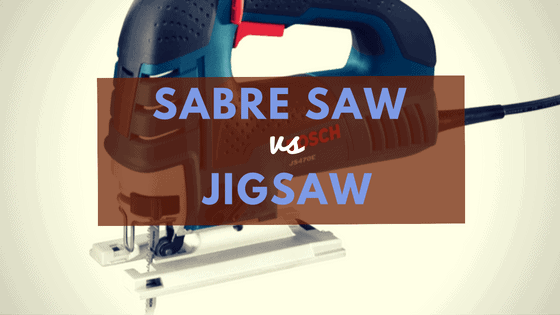The power tool and DIY world are filled to the brim with all sorts of confusing terminology and funny-sounding names. And a lot of times, what someone calls a tool - or a variation of a specific tool - simply depends on what they learned growing up or what part of the country they come from.
Sabre saws (interchangeably spelled ‘saber’) and jigsaws are probably two of the most confusing examples out there.
Both terms refer to portable, handheld electric saws with thin blades that are used for cutting scrolls and other odd, non-linear shapes. Nowadays, 99% of the time these tools are referred to as jigsaws - the term ‘saber’ is becoming more or less obsolete.
Also, to our knowledge there aren’t any manufacturers out there currently marketing anything as a ‘saber saw’.
Regardless, there’s got to be some sort of distinction between the two, right? With curiosity getting the better of us, we took matters into our own hands and ended up treating ourselves to a compelling history lesson on jigsaws, saber saws, and scroll saws - a lesson that took us all the way back to the mid 1800’s.
History of the scroll saw, jig saw, and saber saw
*Full-disclosure: we have no shame in admitting the fact that almost nothing in this article came from our own previous knowledge - we’re power tool experts, not history buffs. Full credit must be given to Eric Hart’s Prop Agenda website, specifically to this article here.
As it turns out, there was never really a massive, clear-cut distinction between a jigsaw and a saber saw. Both names seemed to pop up around the same time in manufacturing catalogs in the 1940’s and 50’s; some companies used the term jigsaw, others used the term saber saw - even though they were marketing the same tool. In fact, one company called Power House apparently said ‘screw it’, and decided to call their tool a Sabre Jig Saw.
But where did the terms come from originally?
To answer that question, we have to jump back in time 160 or so years to the advent of a tabletop ‘jigging and scrolling’ saw.
The term ‘jigging’ simply meant that the saw blade reciprocated up and down, while the term ‘scrolling’ meant that it was for cutting non-linear shapes (scrolls). Some people called these tools jig saws, others called them scroll saws. Nowadays, we almost exclusively refer to stationary, non-portable saws like these as scroll saws.
In the 1940’s, a Swiss engineering company called Scintilla came up with the brilliant idea to make a portable, handheld version of the big tabletop ‘scrolling’ saw. They called the tool the Lesto Jigsaw, and it was so successful that every power tool manufacturer on the planet soon followed suit and started manufacturing similar tools, calling them jigsaws.
In the decades that followed, different manufacturers introduced dozens of new improvements and variations on this popular new tool. One of them was the ability to attach a bigger, thicker blade that was intended for cutting steel - this bigger blade was called a ‘saber blade’.
Thus begins the onslaught of confusion.
Some manufacturers were labeling their electric, handheld jigging/scrolling saws as saber saws (even though they didn’t have the big saber blade), while others were calling them jigsaws. And of course, the sly dogs over there at Power House were confusing the hell out of everybody and calling their tool a Saber Jig Saw.
Since the original terminology ‘saber’ was meant to designate a heavy-duty metal-cutting blade that could be put on portable jigsaws, we really ought to think of saber saws as the predecessors of modern day reciprocating saws.
To summarize, the terms saber saw and jigsaw were essentially used interchangeably from the 1940’s all the way up through about the 1980’s. Thus, you still hear plenty of ‘older generations’ referring to contemporary jigsaws as saber saws. For all extensive purposes, there’s no difference between the two.
With the introduction and popularity of the reciprocating saw (sawzall) though, the term saber saw is no longer being used at all, and will probably be obsolete in a decade or so. Like we said, to our knowledge no one is currently manufacturing anything called a saber saw.
Looking to buy one?
Has all this talk of jigsaws, scroll saws, sabre saws and reciprocating saws got you in the mood for tool shopping? If so, check out our user-friendly saw buying guides and full product reviews:
For in-depth reviews and a list of our favorite jigsaws (or saber saws), click here.
For our favorite reciprocating saws (AKA "sawzall"), check out our article, and for our reviews and opinions on the best scroll saws on the market.


Well, I beg to differ with your opinion on the “Jig saw” terminology, as I am 76 now, and I grew up using a table top ” jig saw” which consisted of what looked like a table top “scroll saw” which has two parallel arms holding the blade, but it had a SOLID top arm with a cylinder at the tip which contained a coil spring, to which the scroll saw type blade was attached. So the motor pulled STRAIGHT down on the blade, whereas the scroll saw arms move the blade up an down in an ARC, forward and backward. The “Sabre saw” was known as a hand held, just like the sabre saws of today. Somehow the younger generation is unaware of the original “jig saw” type, so I guess they use the terminology that they see, and not what actually was. Thanks for “listening” ! Mr Bill